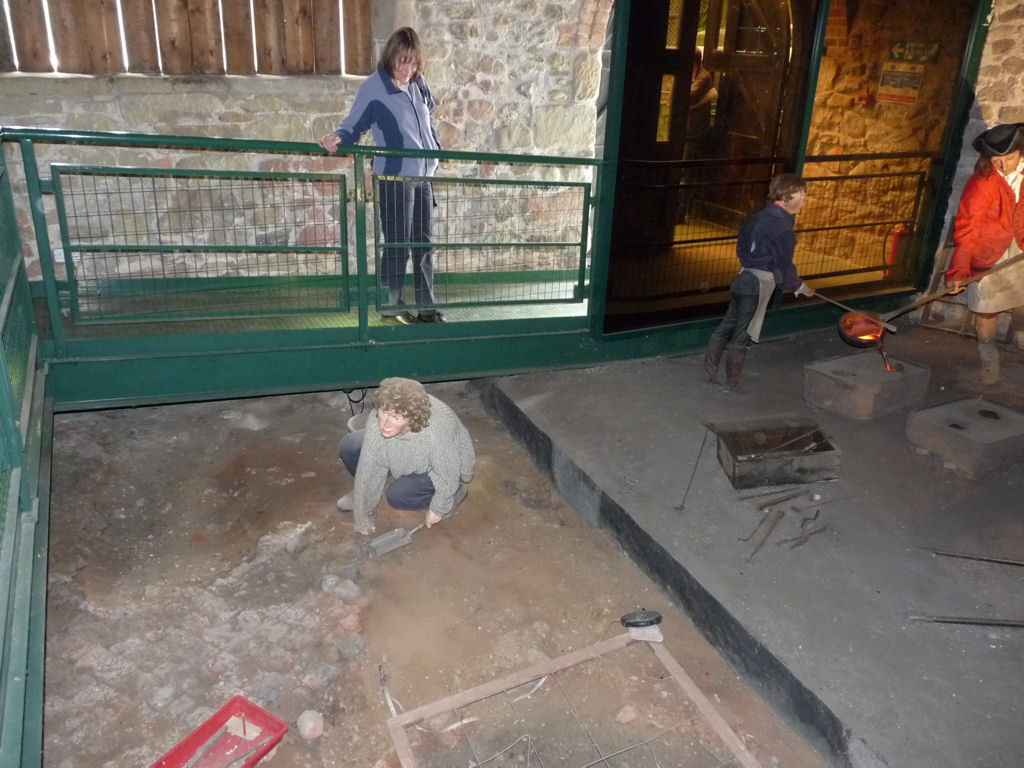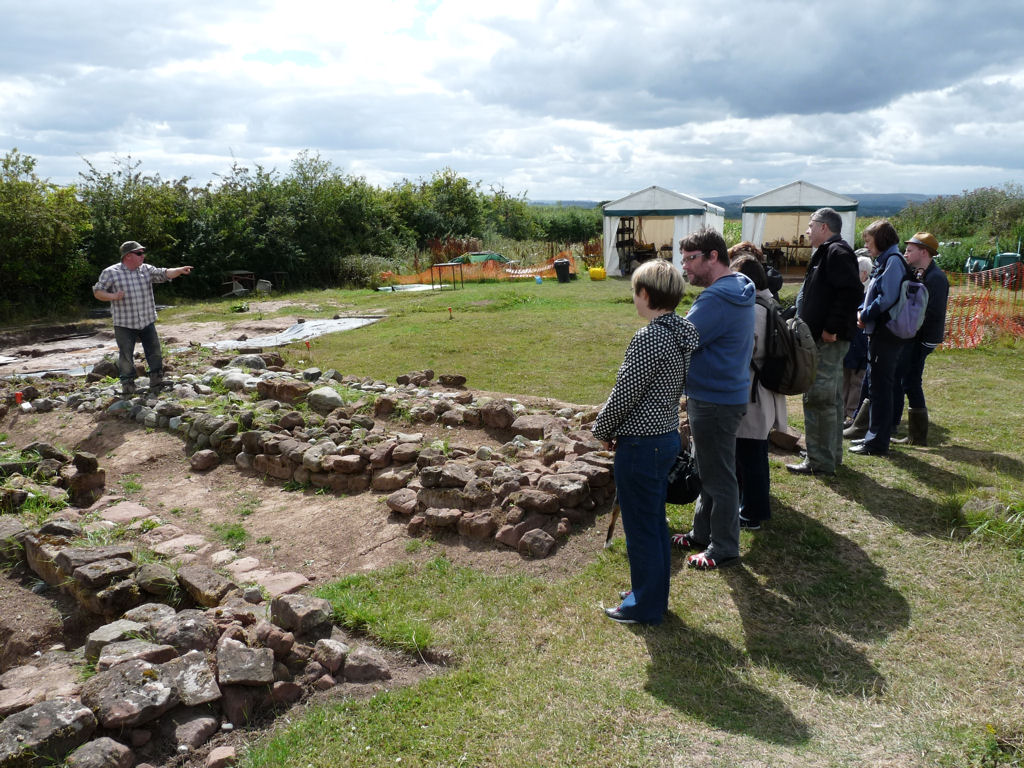Saturday 15th August
We struck lucky with this year’s weather for our annual summer trip which was very enjoyable particularly as our numbers were boosted by members of the Bolton Arch Soc.  Our first site, The Bersham Iron Works, lies just off the Wrexham bypass and was first excavated in the late 1980’s. Our Society actually visited the site in 1995 when a grant from the Welsh Government had enabled it to be preserved and the mill building converted into a museum and heritage centre. Since then however some of the remains have suffered storm damage and lack of funding has caused the centre to now be only open by request. This has not however dampened the enthusiasm of our guide for the day, Steve Grenter, who actually worked on the site in the early nineties.
Our first site, The Bersham Iron Works, lies just off the Wrexham bypass and was first excavated in the late 1980’s. Our Society actually visited the site in 1995 when a grant from the Welsh Government had enabled it to be preserved and the mill building converted into a museum and heritage centre. Since then however some of the remains have suffered storm damage and lack of funding has caused the centre to now be only open by request. This has not however dampened the enthusiasm of our guide for the day, Steve Grenter, who actually worked on the site in the early nineties. Steve eloquently explained that the site first developed making iron in the late 17th century when the technique of making iron from cokes instead of charcoal was only just being developed. In 1716 the site was in the hands of Charles Lloyd who struggled to make it a going concern. In was taken over in 1753 by Isaac Wilkinson who expanding the works to produce pots, pipes, rollers and armaments, however he too ended up in financial difficulties. It was only when his son, John Wilkinson, took over in 1763 that the works became a financial success.
Steve eloquently explained that the site first developed making iron in the late 17th century when the technique of making iron from cokes instead of charcoal was only just being developed. In 1716 the site was in the hands of Charles Lloyd who struggled to make it a going concern. In was taken over in 1753 by Isaac Wilkinson who expanding the works to produce pots, pipes, rollers and armaments, however he too ended up in financial difficulties. It was only when his son, John Wilkinson, took over in 1763 that the works became a financial success.  ‘Iron Mad’ John as he was know was an inventor and experimenter. He was able to exploit the need for cannon which was in particular demand for the American War of Independence and later the Napoleonic Wars. Iron was preferred over brass for these weapons as it was stronger and therefore lighter. However it was difficult to get good quality cast iron and accurate bores so cannon balls sometimes got jammed causing the gun to explode. John however was able to produce the quality needed by re-melting iron in air-furnaces and produced accurate bores using a boring bar.
‘Iron Mad’ John as he was know was an inventor and experimenter. He was able to exploit the need for cannon which was in particular demand for the American War of Independence and later the Napoleonic Wars. Iron was preferred over brass for these weapons as it was stronger and therefore lighter. However it was difficult to get good quality cast iron and accurate bores so cannon balls sometimes got jammed causing the gun to explode. John however was able to produce the quality needed by re-melting iron in air-furnaces and produced accurate bores using a boring bar. Remains of the air-furnaces (predecessor of the open hearth furnace) can still be seen on the Bersham site – as is the blast furnace and the octagonal shed where the canon were cast. Steve, our guide was able to explain how four air-furnaces were located around the shed to enable enough iron to be melted for the casting process.
Remains of the air-furnaces (predecessor of the open hearth furnace) can still be seen on the Bersham site – as is the blast furnace and the octagonal shed where the canon were cast. Steve, our guide was able to explain how four air-furnaces were located around the shed to enable enough iron to be melted for the casting process.  Steve also took us inside the mill building which housed a huge waterwheel used to power the corn mill when iron making on the site ceased. Exhibits included iron products and reconstructions of the iron casting process and excavation of the underlying iron works.
Steve also took us inside the mill building which housed a huge waterwheel used to power the corn mill when iron making on the site ceased. Exhibits included iron products and reconstructions of the iron casting process and excavation of the underlying iron works. After the a very entertaining visit we travelled a mile or so up the Clywedog Valley to the Nant Mill Heritage Centre for our lunch, before travelling north to our second site, The Poulton Research Project.
After the a very entertaining visit we travelled a mile or so up the Clywedog Valley to the Nant Mill Heritage Centre for our lunch, before travelling north to our second site, The Poulton Research Project.
We met our second guide of the day, Kevin Cootes, outside the gates of huge estate. Having let us in through the electric gates, Kevin led us for some distance across the remains of an enormous airfield (once served as training site for Bomber Command in the 2nd WW).  After a brief introduction, Kevin, with is trusty companion Seamus the dog, led us to the site which lay across the fields at the end of one of the runways. It’s insane – it’s bonkers. These are the words Kevin uses to describe the amount of archaeology he is finding on this multi-period site.
After a brief introduction, Kevin, with is trusty companion Seamus the dog, led us to the site which lay across the fields at the end of one of the runways. It’s insane – it’s bonkers. These are the words Kevin uses to describe the amount of archaeology he is finding on this multi-period site. Kevin, who is the current site director, gave a very enthusiastic rundown of the site starting with the Mesolithic flints and Neolithic hand tools. The main features on display in the open trench, however, date from the Iron Age and are a series of overlapping ring ditches representing the remains of roundhouses showing occupation over a long period of time.
Kevin, who is the current site director, gave a very enthusiastic rundown of the site starting with the Mesolithic flints and Neolithic hand tools. The main features on display in the open trench, however, date from the Iron Age and are a series of overlapping ring ditches representing the remains of roundhouses showing occupation over a long period of time. Cutting through these ditches which are quite deep, are Roman boundary ditches which suggests the area became part of a Roman estate. Kevin is convinced there must be a villa somewhere in the area (although it could well lie under the concrete of the runway).
Cutting through these ditches which are quite deep, are Roman boundary ditches which suggests the area became part of a Roman estate. Kevin is convinced there must be a villa somewhere in the area (although it could well lie under the concrete of the runway). In the Medieval a Cistercian Abbey is documented in the area however the remains discovered on the site are of a chapel dating to the 15th century – although there is evidence of earlier Saxons occupation on the site.
In the Medieval a Cistercian Abbey is documented in the area however the remains discovered on the site are of a chapel dating to the 15th century – although there is evidence of earlier Saxons occupation on the site. What is significant however is the number burials associated with it the chapel. Quite a number have already been excavated but Kevin estimates there could well be hundreds more. This part of the site is currently being used for training forensic students. Kevin is sure that there is huge potential for the site and expects excavations to continue for many years to come. The Poulton Research Project allows volunteer so anyone can come and have a go. Taster weekend are free but more regular visits would require membership. After the tour Kevin invited us to tea and cake which topped a very entertaining afternoon – in fact the whole day proved a great success .
What is significant however is the number burials associated with it the chapel. Quite a number have already been excavated but Kevin estimates there could well be hundreds more. This part of the site is currently being used for training forensic students. Kevin is sure that there is huge potential for the site and expects excavations to continue for many years to come. The Poulton Research Project allows volunteer so anyone can come and have a go. Taster weekend are free but more regular visits would require membership. After the tour Kevin invited us to tea and cake which topped a very entertaining afternoon – in fact the whole day proved a great success .

This maybe a strange request, but I came across your 2015 report of a visit to the Bersham Ironworks, which Charles Lloyd developed circa 1716 to supply the forge at Pont y Blew. Sadly the forge is in the Chirk area and as far as I know their aviation and mines museum closed about 2017, so I wondered if you had any contacts in that area.
My interest is in the possibility that after Bersham closed in 1812, Pont Y Blew or the neighbouring Glyn Morlas furnace used ironstone as a feed. Specifically in Edward Lloyd CE (1803-83) who developed a local tramway, and was probably a surveyor or engineer in Telford’s London Holyhead road.
I was born in Widnes in 1947, and attended Manchester University but am now in Canada, so would have difficulty visiting these sites, so would be grateful if you know of anyone with knowledge in the area.
Thanks
Peter Broad